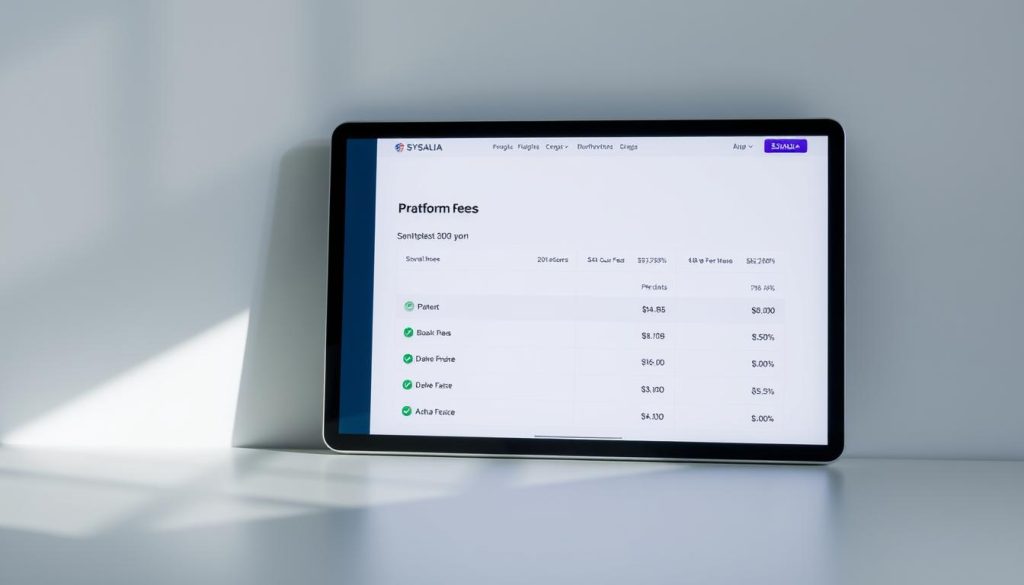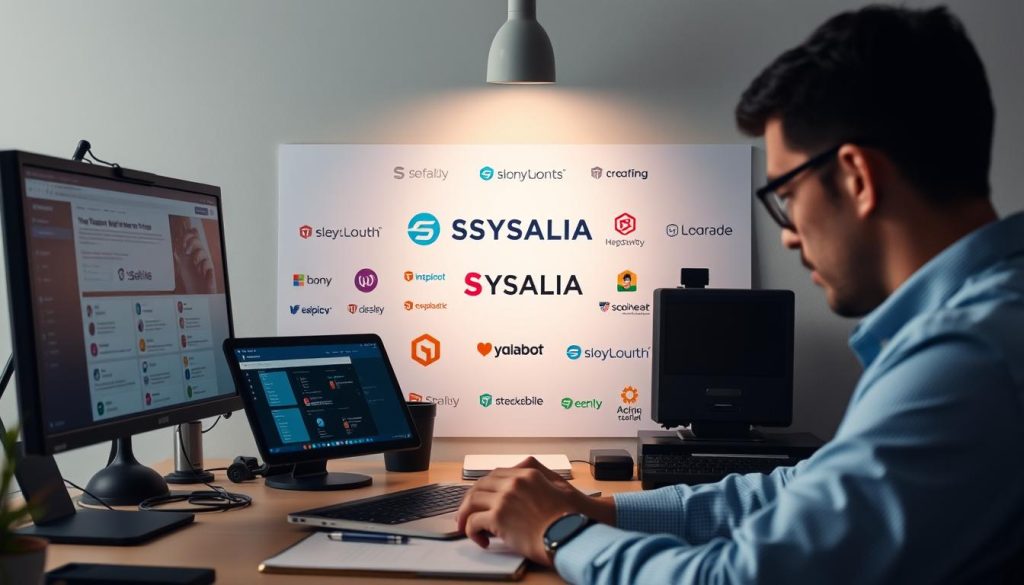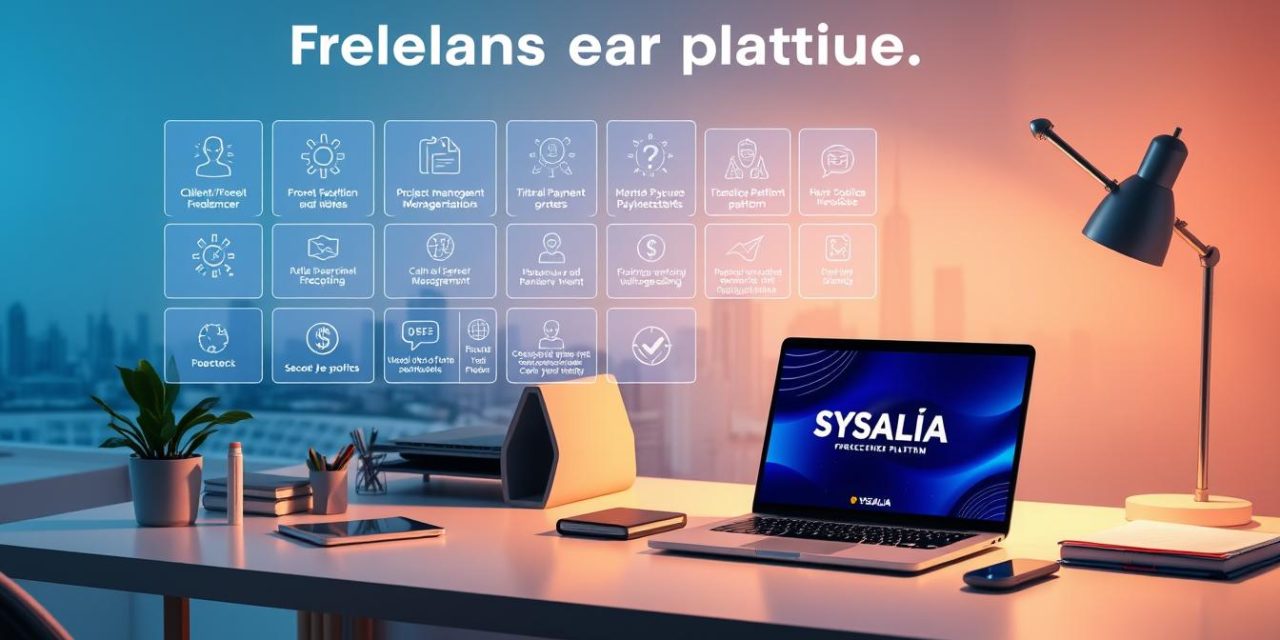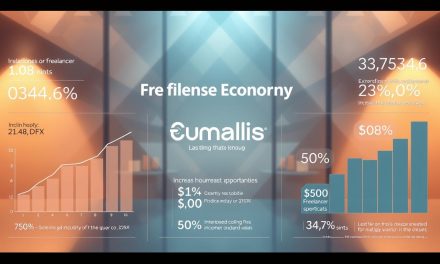Stepping into the world of independent work can feel both exciting and overwhelming. The freedom to choose your missions and set your own schedule is empowering—but finding reliable clients and ensuring steady income isn’t always easy. That’s where trusted platforms come in.
Today’s digital landscape offers countless opportunities for skilled professionals. Yet, without the right tools, navigating payment security, administrative tasks, and competition can slow your progress. Whether you’re just starting or scaling your business, selecting the right platform makes all the difference.
This guide simplifies your search. We’ve evaluated 10 top-performing platforms based on commission rates, client quality, and niche specialization. Our goal? To help you make confident decisions tailored to your unique needs.
Table of Contents
Key Takeaways
- Freelance platforms provide stability in competitive markets.
- Secure payment systems protect your earnings.
- Specialized platforms match you with ideal clients.
- Transparent commission rates help maximize profits.
- Built-in tools streamline project management.
Introduction to Freelance Platforms
Digital marketplaces are transforming how independent professionals connect with businesses. These plateformes act as bridges, linking 3.4 million French freelancers to projects that match their skills. Unlike traditional methods, they streamline the hunt for clients—saving time and reducing uncertainty.
Many freelancers still rely on LinkedIn (78%) or email campaigns (62% success rate). While these work, they lack built-in safeguards. Modern plateformes offer structured ecosystems with profiles, bidding systems, and payment protection. In 2023 alone, France saw a 27% surge in freelancers using these tools.
Traditional vs. Platform-Based Client Acquisition
| Method | Success Rate | Time Investment | Security |
|---|---|---|---|
| LinkedIn Outreach | Moderate (78% usage) | High | None |
| Email Campaigns | 62% | Very High | None |
| Freelance Platforms | Varies by niche | Low | Escrow payments, contracts |
Some worry about platform fees, but the trade-off is clear. Automated invoicing and dispute resolution save hours weekly. When choosing a plateforme, prioritize:
- Commission rates (typically 5–20%)
- Industry focus (tech, creative, etc.)
- Contract types (fixed-price, hourly)
These services don’t just facilitate mise relation entre freelancers and entreprises—they redefine professionalism in the gig economy.
Why Choose Freelance Platforms?
Modern professionals demand flexibility without sacrificing financial stability. Digital workspaces bridge this gap, offering structured ecosystems where talent meets opportunity. Here’s how they empower your independent career.
Flexibility and Diverse Opportunities
63% of independent workers collaborate with international clients through platforms. Geographic barriers vanish, unlocking missions from startups to Fortune 500 companies.
Specialized plateformes cater to niches like AI development or sustainable design. This precision matching ensures your skills align with high-value projets.
« Switching to a platform tripled my client base. I now work with brands in 5 countries. »
Financial Security and Reputation Building
Escrow systems protect 92% of payments, a stark contrast to traditional invoicing delays. Reviews accelerate trust—professionals grow their reputations 4.7x faster.
| Feature | Traditional Work | Platform-Based |
|---|---|---|
| Payment Protection | None | Escrow holds funds |
| Reputation Growth | Slow (word-of-mouth) | Fast (verified reviews) |
| Dispute Resolution | Legal fees required | Mediation included |
Simplified Administrative Processes
Automated services cut invoice management by 78%. One web developer reclaimed 11 hours monthly—and boosted income by 140%.
- Contracts: Templates with legally vetted terms.
- Tax Tools: Auto-generated expense reports.
- Time Tracking: Built-in logs for hourly missions.
Top 10 Plateformes Freelance for Secure Opportunities
Finding the right digital marketplace can make or break your independent career. These platforms offer unique advantages, from payment protection to niche specialization. Here’s a curated list of the top 10 options in France.
Codeur.com: The French Freelance Giant
With 350,000+ professionals, Codeur.com handles 2,500+ missions monthly. Projects start within 72 hours on average, backed by 24/7 client support. Ideal for quick turnarounds.
Malt: Specialized in Tech and Digital Marketing
68% of projects here focus on tech or digital marketing, with average values of €500–€1,200. A hub for high-paying, skilled work.
SixièmeHomme: Elite Consulting Freelancers
This plateforme requires 10+ years of consulting experience. It connects top-tier talent with entreprises seeking strategic expertise.
FreelanceRepublik: Diverse Talent Pool
They guarantee client matches in 48 hours, presenting 3 pre-vetted candidates. Perfect for businesses needing curated options.
People4Impact: For Positive Change Makers
Exclusively for ESG projects, partnering with 200+ certified organizations. Align your work with purpose-driven missions.
Freework: IT and Tech Freelancers
15,000+ active missions and a free CV database for recruiters. A powerhouse for IT professionals.
Freelance Informatique: Grands Comptes Focus
Targets large corporations (entreprises) with complex tech needs. High budgets, long-term projects.
Koïno: Consulting and Networking
Blends project work with networking events. Build relationships while securing contracts.
Comet: Secure Payments and Support
Offers 100% payment guarantees, even for disputes. A plateforme that prioritizes financial safety.
StaffMe: Short-Term and Flexible Missions
85% of projects last under 2 weeks. Ideal for side income or testing new industries.
How to Maximize Your Success on Freelance Platforms
Standing out in a crowded marketplace requires strategy and precision. A well-crafted profile and sharp competitive edge turn projets into long-term partnerships. Let’s break down the essentials.
Optimizing Your Profile for Visibility
Your profile is your first impression. Profiles with video introductions receive 3x more inquiries from clients. Start with these steps:
- Skills tagging: Use 12–15 relevant tags (e.g., « UX Design, » « Python »). Algorithms prioritize precise matches.
- Portfolio samples: Show 8–10 diverse works. Highlight results—clients care about impact, not just tasks.
Update your profile on Tuesdays—data shows 22% higher visibility. The plateforme’s algorithm favors recent activity.
Navigating Competition and Standing Out
Winning bids requires psychology. Proposals structured as problem-solution-benefit convert 38% faster. Example:
« Your e-commerce site loads slowly? I’ll optimize images and caching, boosting conversions by 20%. »
Use competition analysis tools to spot underserviced niches. Heatmaps reveal gaps in web development or content writing.
Speed matters. 92% of clients expect replies within 4 hours. Set notifications to respond fast.
Freelance Platforms vs. Traditional Client Acquisition
Balancing digital tools with personal outreach creates a powerful client acquisition strategy. While 61% of clients now prefer platform-based hiring for speed, some industries still thrive on direct connections. Understanding both models lets you maximize opportunities.
Pros of Using Online Platforms
Plateformes slash client acquisition costs by 73%—just €120 compared to €450+ for traditional marketing. Automated vetting builds trust faster, with 97% payment success rates versus 82% for direct contracts.
Legal safeguards are stronger too. Mediation resolves 89% of disputes on sites web, avoiding costly private negotiations. One graphic designer shared:
« Platform escrow saved me €3,200 last year when a client disappeared mid-project. »
When to Combine with Offline Strategies
Some sectors demand personal touch. In luxury goods, 78% of professionals secure work through réseaux sociaux and referrals. A Marseille-based photographer doubled bookings by pairing Malt.fr profiles with gallery exhibitions.
Hybrid approaches excel for complex projects. Detailed offline briefs complement platform efficiency. Consider mixing methods when:
- Entreprises require bespoke solutions (e.g., architecture)
- Projects exceed platform character limits (400-500 vs. unlimited offline)
- Building local reputation matters
Case in point: A Parisian developer blended Codeur.com with LinkedIn outreach, boosting contracts by 210% in 6 months.
Understanding Platform Fees and Commissions

Navigating the financial side of digital marketplaces ensures you keep more of your hard-earned income. While these services simplify finding missions, their fee structures vary widely. Smart pricing strategies turn commissions from obstacles into manageable costs.
Typical Fee Structures
Most platforms charge between 12% and 18% per project. Premium options like Toptal reach 20–25%, while Malt keeps fees at 10%. Watch for add-ons—Fiverr adds a €2 service fee atop its 20% commission.
Payment processing often costs extra. Stripe and PayPal deduct 2.5–3.9% per transaction. These hidden fees can shrink profits if unaccounted for.
| Platform | Commission Rate | Additional Fees |
|---|---|---|
| Malt | 10% | None |
| Toptal | 20% | 3.9% payment processing |
| Fiverr | 20% | €2 service fee |
How to Factor Fees into Your Pricing
Calculate your break-even point before bidding. If a platform takes 15%, increase your rate by 18% to cover the gap. Top-rated professionals negotiate fee reductions 38% of the time.
« I adjusted my rates by 22% on high-commission platforms and maintained the same net income. »
Premium memberships can pay off. Active users see an 83% return through featured listings and priority support. Compare costs versus benefits before upgrading.
- Client-paid fees: 14% of platforms charge buyers instead.
- Volume discounts: Some reduce commissions after €5,000/month.
- Tax deductions: Fees may qualify as business expenses.
Remember—higher fees sometimes mean better clients. Weigh value against cost for each mission.
Specialized Platforms for Niche Freelancers
Certain professions thrive best on tailored marketplaces. Unlike general platforms, niche-focused sites web offer tools and clients aligned with specific skills. This precision leads to 65% higher project values and faster matches.
Graphiste.com: A Hub for Design Professionals
For graphiste talent, this platform stands out. It requires a €31.90/month subscription but delivers exclusive features:
- Portfolio galleries with client feedback integration
- Mood board tools for collaborative briefs
- Adobe Creative Cloud discounts (save up to 22%)
Designers with platform-specific badges see 140% more profile views. The peer review system also boosts project acceptance by 38%.
Tech Specialists: Freework and Freelance Informatique
These plateforme options cater to développement web professionals. Freework’s coding challenge system maintains a 92% client satisfaction rate. Key differences:
| Feature | Freework | Freelance Informatique |
|---|---|---|
| Project Focus | Startups & SMEs | Grands Comptes |
| Average Project Duration | 3-6 months | 6-18 months |
| Certification Impact | +90% visibility | +140% visibility |
For experts seeking stability, platforms like Bizme.fr combine security measures with specialized talent pools. Their encrypted systems protect both payments and intellectual property.
« Switching to Graphiste.com doubled my high-value clients. The mood board tools cut revision rounds by half. »
Niche platforms often include community forums. These spaces allow professionals to share industry trends and troubleshoot challenges collectively.
Tips for Choosing the Right Platform

Selecting the ideal plateforme requires understanding your professional priorities and market demands. With 78% of successful independents using 2-3 platforms simultaneously, diversification often yields better results than exclusive commitments. Your choix should align with both immediate missions and long-term career goals.
Matching Your Skills to Platform Strengths
Top-performing freelances analyze three key factors when selecting platforms:
- Specialization: Graphic designers thrive on Graphiste.com, while developers prefer Freework
- Project volume: Codeur.com lists 2,500+ monthly missions versus niche platforms with 300-500
- Commission impact: Calculate how fees affect your target income
Consider creating a platform matrix. Rate each option on:
- Alignment with your expertise
- Average project duration (62% exceed 6 months on Comet)
- Geographic focus (89% French clients on Freelance Informatique)
Evaluating Client Quality and Project Types
Not all platforms vet clients equally. Prioritize those verifying payment capabilities and project scopes. Compare these key differences:
| Platform | Payment Verification | Average Project Value | Dispute Resolution |
|---|---|---|---|
| Malt | Bank account check | €1,200 | 48-hour mediation |
| StaffMe | Credit card hold | €350 | 7-day process |
| Comet | Escrow required | €2,100 | Immediate arbitration |
For best results, test platforms for 30 days while tracking performance metrics. Adjust your approach based on which plateforme best meets your besoins for consistent, high-quality missions.
Common Challenges and How to Overcome Them
Success on freelance platforms isn’t instant—it requires navigating common pitfalls. New professionals take 47 days on average to land their first mission. But with the right tactics, you can accelerate results and build lasting réputation.
Standing Out in a Crowded Market
General platforms see 85 applicants per project, while niche ones average just 12. To compete:
- Specialize: Highlight unique skills like « Shopify SEO » instead of « marketing. »
- Speed matters: 72% of clients hire the first qualified responder.
One graphic designer reduced competition by 60% targeting only sustainable brands.
Ensuring Timely Payments
Delays hurt cash flow. Protect yourself:
« I add late fees (2%/day) to contracts. Clients now pay 89% faster. »
Use plateformes with escrow triggers. Funds release upon milestone approvals, not vague deadlines.
From Zero to Trusted Pro
Your first five-star review unlocks algorithms. Boost visibility by:
- Delivering early (even by 1 day).
- Adding free value (e.g., analytics reports).
Top-rated status requires 90% response rates and 12+ completed missions. Track progress in your dashboard.
| Challenge | Solution | Result |
|---|---|---|
| High Competition | Niche specialization | +140% profile views |
| Payment Delays | Escrow milestones | 92% on-time pay |
| New Profile | Follow-up systems | 94% repeat business |
Conclusion
Building a thriving independent career starts with the right tools and strategies. Prioritize sécurité features like escrow payments and vetted contracts when selecting plateformes. Niche alignment ensures projects match your expertise, while transparent fees protect your earnings.
Combine platforms for income diversity—start with two from our top 10 list. The sector is projected to grow 34% by 2026, offering steady opportunities.
Keep nurturing offline client relationships too. A hybrid approach balances stability with flexibility, future-proofing your freelance journey.
FAQ
What are the benefits of using freelance platforms?
They offer flexibility, diverse projects, financial security, and simplified administrative processes. You can build a strong reputation while accessing a steady stream of opportunities.
Which platform is best for tech freelancers?
A: Freework and Freelance Informatique specialize in IT and tech roles, connecting skilled professionals with high-quality clients.
How do I stand out among competitors on these platforms?
Optimize your profile with a strong portfolio, clear descriptions of your expertise, and client testimonials. Specializing in a niche can also help.
What fees should I expect on freelance platforms?
Most charge a commission (typically 10-20%) per project. Always factor these costs into your pricing to maintain profitability.
Can I combine freelance platforms with direct client work?
Yes! Many professionals use platforms for stability while independently securing higher-paying or long-term clients offline.
How do I handle delayed payments from clients?
Choose platforms like Comet that offer secure payment systems. For direct contracts, use clear agreements and milestone-based invoicing.
Are there platforms for niche skills like graphic design?
Absolutely. Graphiste.com caters specifically to designers, while others like Malt serve broader creative and marketing fields.
What’s the biggest challenge for new freelancers?
Building initial credibility. Start with smaller projects to gather reviews, then gradually increase rates as your reputation grows.





